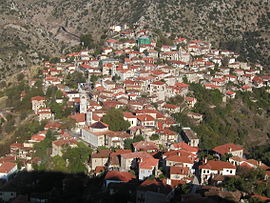Dimitsana
|
Dimitsana Δημητσάνα |
|
|---|---|
 |
|
| Coordinates: 37°36′N 22°3′E / 37.600°N 22.050°ECoordinates: 37°36′N 22°3′E / 37.600°N 22.050°E | |
| Country | Greece |
| Administrative region | Peloponnese |
| Regional unit | Arcadia |
| Municipality | Gortynia |
| • Municipal unit | 110.8 km2 (42.8 sq mi) |
| Elevation | 945 m (3,100 ft) |
| Population (2011) | |
| • Municipal unit | 763 |
| • Municipal unit density | 6.9/km2 (18/sq mi) |
| Time zone | EET (UTC+2) |
| • Summer (DST) | EEST (UTC+3) |
| Postal code | 220 07 |
| Area code(s) | 27950 |
| Vehicle registration | TP |
| Website | www |
Dimitsana (Greek: Δημητσάνα) is a mountain village and a former municipality in Arcadia, Peloponnese, Greece. Since the 2011 local government reform it is part of the municipality Gortynia, of which it is the seat and a municipal unit. The municipal unit has an area of 110.759 km2. Dimitsana is built on the ruins of the ancient town Teuthis. The population of the village is 342 (2011 census), while it was 611 in 2001. It has been registered as a traditional settlement.
Dimitsana is built on a mountain slope at an elevation of 950 meters. From its southern side a marvelous view of Megalopolis plain and Taygetus is provided. Dimitsana is located 53 km east of Pyrgos, 31 km northwest of Tripoli, 23 km northwest of Megalopoli and 17 km northeast of Andritsaina. The village has a school, a historical library, several churches, a post office, an open-air water-power museum, an open amphitheater, hotels and a square.
At the site of present-day Dimitsana there was, in ancient times, the ancient Arcadian town Teuthis that had participated in the Trojan War, but also in the colonization of Megalopolis.
In 963 Philosophou Monastery was founded 2,5 km from Dimitsana. The name of the town is first recorded in 967 in a Patriarchate's document related to Philosophou Monastery. The first gunpowder mills of the town were built under the guise of home industry in the middle of the 18th century by Bishop Ananias Lakedaimonias, who paved a revolt against the Turks. In 1764 the movement was revealed and Ananias and his partners were killed. In the same year Agapios, a wise monk, built a library, where he moved the books of the monastery. The library was growing up constantly until 1821, as the Patriarchate offered new books and there was operating a seminary, known as Φροντιστήριο Ελληνικών Γραμμάτων (Tuitin Centre of Greek Literature). A lot of bishops and scholars graduated from it, among them Patriarch Gregory V of Constantinople and Germanos III of Old Patras whose houses have survived in the town.
...
Wikipedia


